Nowadays, many kitchen utensil materials are in the market, from metals to woods to glasses and synthetic ones. We will discover the pros and cons of each material, which ones are safe to use and which ones are not. And at last, you can decide which ones are worth investing in.
- 11 Different Materials for Kitchen Utensils
- What Materials are Cooking Utensil Handles Made of?
- Which Cooking Utensil Material is Best for Health?
- Which Materials of Cooking Utensils Should You Avoid?
- How to Choose the Right Materials for Your Kitchen Utensils?
- Which Stainless Steel is Best for Cooking?
- Nylon Vs Silicone Cooking Utensils
1. 11 Different Materials for Kitchen Utensils
Whenever someone goes to the market to buy cookware utensils, there are many materials to choose from. It becomes impossible to decide which material utensils will give the best results and are safe to use. Last but not least, durability and price are also the major factors to consider.
Below are 11 different materials with their pros and cons;
- Nylon
- Silicone
- Stainless steel
- Wood
- Glass
- Teflon
- Ceramic
- Aluminum
- Plastic
- Cast iron
- Copper
Nylon
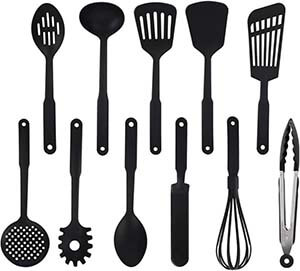
Nylon is a synthetic material. It is a bad conductor of heat, so it is the material widely used to make stirring spoons, spatulas, e.t.c.
Pros
- Does not react with food
- Silky-smooth surface finish
- Can be washed in a dishwasher
- Flexible, easy to reach hard places
- Does not scratch cookware surface
- Heat resistant up to 400° F ( 4° C )
- More smell and stain-resistant than wood
Cons
- Not biodegradable
- Less durable than silicone
- Can crack more easily than silicone and harbor bacteria
- May release DDM a harmful chemical into food when heated above 400° F ( 4° C )
Silicone
Silicone is a compound made up of quartz sand, carbon, hydrogen, oxygen, and maybe more elements. All of these elements are non-harmful. According to the FDA, silicone products are safe to use. Silicone is widely used to make mats, spatulas, spoons, whisks, e.t.c.
Pros
- Bad conductor of heat
- Does not react with food
- Flexible nature, easy to reach hard places
- Non-abrasive nature, best for coated non-stick surfaces
Cons
- Not biodegradable
- May leach some chemicals when overheated
Stainless steel
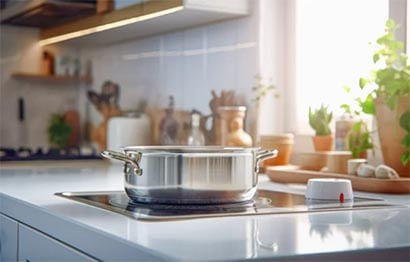
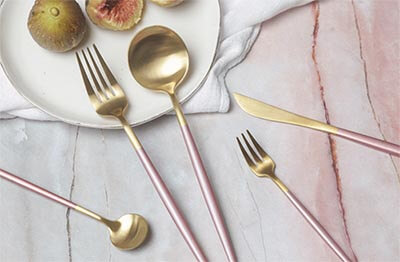
Stainless steel has always been the preferred material in kitchen utensils, such as stainless steel knives, forks, pots, plates, etc. It mainly comes in two types: 304 and 316. Common foods typically do not pose any harm to 304 stainless steel, so there’s no need to worry about food corroding the steel and producing harmful substances or concerns about direct ingestion.
However, when it comes to certain specific foods like carbonated beverages, milk, coffee, etc., 304 stainless steel may seem a bit weak. In such cases, we need stainless steel with stronger corrosion resistance—316 stainless steel. It offers slightly higher corrosion resistance than 304 stainless steel, with not much additional cost, making it widely used.
Pros
- Oven safe
- Rust-resistant
- Dishwasher safe
- Scratch-resistant
- Durable, can last for years
Cons
- Clad stainless steel may become harmful if not maintained well
- Nickel or chromium may leach into food and cause health problems
- Pure stainless steel is not a good conductor of heat; metals such as aluminum and copper are added to increase conductivity
Wood
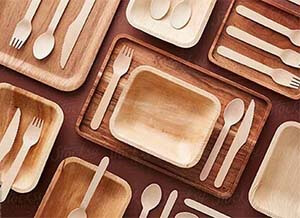
Wooden kitchen utensils have been in use for thousands of years. Wood is mostly used to make stirring and serving utensils, such as spatulas, spoons, plates, dishes, etc.
Different kinds of wood can make a significant difference in cooking, particularly when it comes to grilling or smoking foods. The type of wood used can influence the flavor, aroma, and overall outcome of the dish.
Pros
- Durable
- Does not scratch the non-stick surface
- Unlike other materials, wood is 100% biodegradable
- Does not react with food; acidic or alkaline does not matter.
Cons
- Can pick up smell
- Can be stained easily due to porous surface
- Can break and food can fill in the pores causing sanitary issues
- Can not be washed in a dishwasher because moisture can break wood
Glass
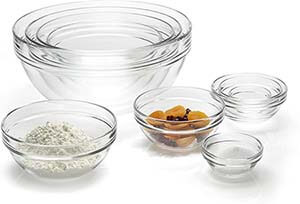
Glass utensils are becoming more and more common nowadays due to their decent appearance, which can fit any kitchen easily. Glass is mostly used to make pans, plates, cups, dishes, and a lot more.
Pros
- 100% Recyclable
- Retain heat for a longer duration
- Can last for 7 to 10 years with proper care
- Does not react with food, not even with acidic foods
- Can be washed in the dishwasher due to their non-porous surface
Cons
- Good conductors of heat but less than metals
- Heavier than metals, plastics, wood, silicone, e.t.c.
- Can break easily either with sudden high temperature or force
- Low-quality utensils can leach lead and other harmful chemicals
Teflon
Teflon is basically a coating to make utensils non-stick, which is also called PTFE.
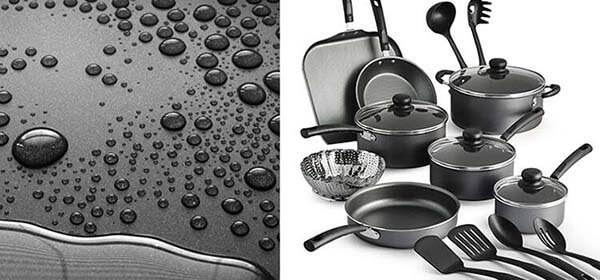
Pros
- Easy cleaning
- Smell and stain resistant
- Gives a premium look to utensils
- Food does not stick to the bottom
- Least friction surface, even sometimes oil is not required
Cons
- PFOA coated utensils are not safe
- PTFE coated utensils can withstand temperature up to 500° F (260 ° C)
- Requires non-abrasive spatulas such as nylon, wood, e.t.c to avoid scratching of surface
Ceramic
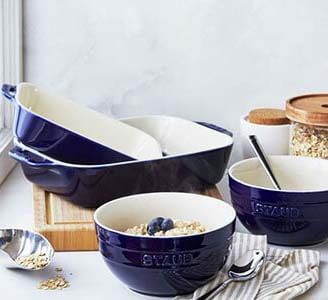
Ceramic is a natural material. Ceramic utensils come in two options: 100% pure ceramic cooking utensils and ceramic coated utensils.
Pros
- Scratch-resistant
- Retain heat very well and conduct heat slowly and evenly
- Smell and stain resistant
- Can be used for years with proper care
- Neither react nor release any chemicals into food, safest than all other materials
Cons
- Most Expensive
- Can be cracked with sudden temperature change
- Ceramic coated utensils are basically metal utensils with a ceramic coating, which can be harmful
Aluminum
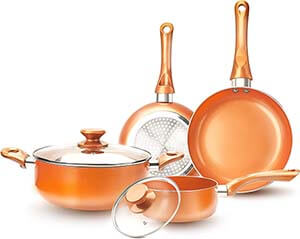
Kitchen utensils made of aluminum are also commonly used. Untreated aluminum cooking utensils are not safe to use. In contrast, aluminum utensils clad with stainless steel or non-stick coated or anodized are safer to use. It is best not to use aluminum utensils daily if you do not want heavy metal leaching into your food.
Pros
- One of the lightest material
- Enhanced aluminum cookwares are non-sticky
- Good conductor of heat only second to copper
Cons
- React with food, can change its odor and flavor
- Pure aluminum kitchen utensils can not be used on induction stoves
- Coated aluminum utensils can release harmful chemicals like lead, cadmium, e.t.c into food
Plastic
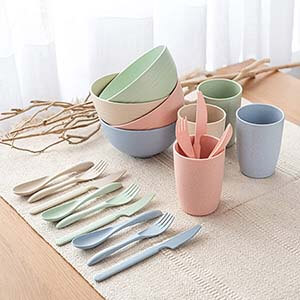
Plastic utensils are used in almost every kitchen in the world. Plastic materials such as nylon, silicone, e.t.c are safe to use while other cheap plastics are not. It is best to avoid plastic utensils other than nylon and silicone as much as possible.
Pros
- Light in weight
- Bad conductor of heat
- Mostly are flexible and sturdy
- Used to make spatulas, spoon, e.t.c
- Does not scratch non-stick surfaces
Cons
- Leach harmful chemicals into food
- Plastic other than nylon and silicon can react with food when heated
Cast iron
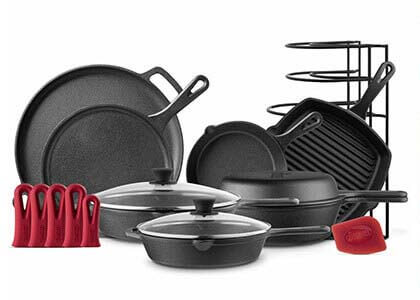
Cast iron is one of the safest cooking utensil materials. Cast iron comes in two options; uncoated cast iron and enameled cast iron.
Pros
- Oven safe
- Can retain heat for longer
- Durable, can last for decades with proper care
- Uncoated cast iron can become better with usage
- Release iron into food which can help in iron deficiency disease
Cons
- Cast iron is prone to rust
- Conducts heat slowly and unevenly
- Heavy-weight than most other materials
- Uncoated cast iron can change the color and taste of acidic food
- Enameled coated cast iron may release harmful chemicals like lead, cadmium, e.t.c
Copper
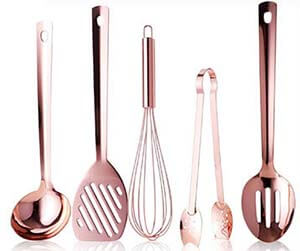
Many professional cooks use copper utensils all around the world. Copper utensils are not very common due to their high price.
Pros
- Distribute heat evenly
- Safe to use in the oven
- Anti-microbial
- Better conductor of heat than other materials such as cast iron, stainless steel, e.t.c.
Cons
- Leach copper into food
- Requires regular polishing to maintain a shiny look
- can be scratched easily
- React with many natural minerals, acidic food, e.t.c, so it is lined with non-reactive compounds, such as tin, stainless steel, e.t.c
2. What Materials are Cooking Utensil Handles Made of?
Usually, cooking utensils handles are made up of the materials which must have most of these properties;
- Durable
- Non-slip
- Oven safe
- Easily cleanable
- Does not dissolve in water
- Should not leach any harmful chemicals
- Scratch-proof, to avoid harboring bacteria
- Insulator or bad conductor of heat, because it will prevent easy moving of utensil without burning of hand during cooking
The materials that have these properties are given below;
- Steel
- Wood
- Nylon
- Plastic
- Silicone
- Bakelite
- Bamboo
- Some more
Among these, wood and plastic handles are the most common because they have most of the above properties, are cheap, and are easily available.
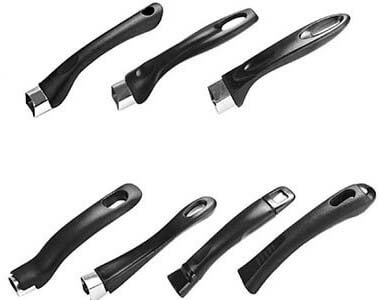
3. Which Cooking Utensil Material is Best for Health?
All the materials which are used to manufacture kitchen utensils and equipment, these 4 below are considered among the safest ones to make heat-conducting cookware;
- Glass
- Ceramic
- Cast Iron
- Stainless Steel
Glass is considered one of the safest materials to cook food because it does not release any harmful chemicals. Glass is also non-reactive and does not react with basic or acidic or any other food. Plus, glass can break easily with force or sudden temperature change.
100% pure Ceramic utensils are completely safe for health. They do not release a single chemical in food. They do not harbor any harmful microorganisms. The only downside is that they are expensive and can break with sudden temperature changes.
Uncoated cast iron does not contain any harmful chemicals such as lead, cadmium, e.t.c because they do not have any coating. They even release iron into food which is beneficial for iron deficiency. Plus, uncoated cast iron requires regular seasoning to prevent rusting, or it can be harmful to health. Overall, cast iron is one of the safest materials in cooking concerning health.
Anodized or coated stainless steel may release a small amount of nickel or cadmium when misused. Still, there is no proof of serious health problems using enhanced stainless steel utensils. Although, it is advised to avoid nickel-containing stainless steel if you have a nickel allergy. Overall, stainless steel is reliable to use.
While to make spoons, whisks, stirring handles, non-sticking mats, e.t.c these below materials are considered the safest;
- Wood
- Nylon
- Silicone
- Bamboo
Silicone lies at the top because it does not leach any chemicals into food and is crack resistant. While wood, bamboo, and nylon also do not leach any chemicals, but they can be cracked over time and harbor bacteria. Wood and bamboo utensils are needed to replace more frequently than silicone and nylon ones to avoid sanitary problems.
4. Which Materials of Cooking Utensils Should You Avoid?
These below are 4 materials that you should avoid using as cookware for cooking food, or mixing handles, or storage containers, or serving equipment if you want to avoid harmful chemicals in your food;
- Teflon (PTFE)
- Copper
- Aluminum
- Cheap Plastic
Teflon: PFOA was previously used to manufacture Teflon. But PFOA can cause many liver, thyroid, cancer, infertility, and other diseases. So, PFOA was banned in 2015. Now, PTFE is used as a coating agent, which is safer than PFOA. But some manufacturers still use PFOA, or low standard PTFE or other cheap chemicals for coating. So, it is best to avoid Teflon cookware if you do not know the brand’s quality.
Copper: Copper is a better conductor of heat than most other materials. But pure copper utensils can release copper into food, while tin, stainless steel, e.t.c coated copper utensils may release other harmful chemicals. Plus, copper is also expensive. It is best to avoid copper utensils if you do not know how to buy the safest ones.
Aluminum: Aluminum utensils no doubt release aluminum into foods. Even premium quality anodized and coated aluminum cookware can become harmful after some use. Especially coated utensils need proper care to avoid chipping off of coatings to prevent releasing toxic agents such as lead, cadmium, e.t.c. While most sellers claim anodized aluminum is safe to use, but the quality is still the issue. So, avoid aluminum cookware as much as you can.
Cheap Plastic: At last, you should avoid plastic other than nylon and silicone at all costs. Because spoons, spatulas, containers, jars, and many other kitchen equipment made up of cheap plastics can cause serious health problems. It is better to invest in wood, bamboo, bakelite, nylon, silicone, and other safe materials to make mixing utensils, containers, and similar products like this where insulating heat is the main goal.
5. How to Choose the Right Materials for Your Kitchen Utensils?
You can choose the right material for your kitchen utensil and equipment based on the following factors;
- Price
- Lifespan
- Cleaning
- Safe level
- Oven/Microwave safe
- Heat conduction
Price
Well, who does not want premium quality kitchen utensils and equipment at low prices? But cheaper cooking utensils and equipment can be harmful to health because of low-quality chemicals and raw materials used in their production. So, it is best to invest once in the best quality products to avoid health issues.
Below is the comparison of all the material prices:
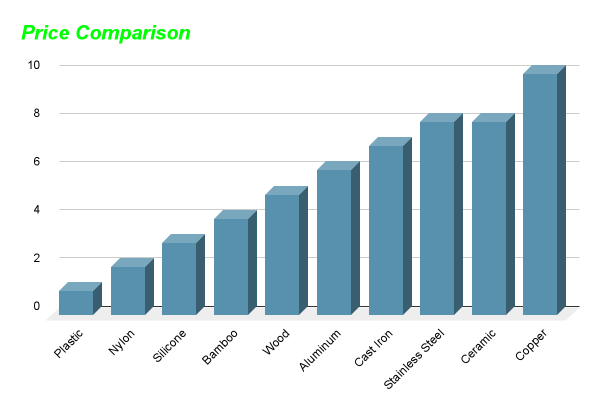
Safety Level
This is one of the main concerns which you should look for when buying any utensils. It is best to invest in pricey, safe utensils than spend a lot of money and hours curing the diseases.
The materials mentioned above are categorized as below;
Safest materials: Cast iron, glass, ceramic, wood, bamboo, and silicone cooking tools do not leach any known harmful chemicals into food.
Safe with proper care: Coated-Copper, nylon, enhanced aluminum, and stainless steel leach chemicals into food when their protective upper coating is scratched or chipped off.
Not safe: Cheap Plastic cooking utensils and equipment are never safe to use.
Lifespan
Some of the above materials can last for decades, while others can only last for years or months at maximum.
Decades life span: Copper, ceramic, glass, and cast iron utensils can last for decades with proper care.
Years life span: Stainless steel and aluminum cookware can last for years if cared for well.
Months Lifespan: Nylon and silicone can last for more months than wood and bamboo cooking tools. In contrast, cheap plastic products have the lowest lifespan.
Heat Conduction
If you want to make handles or serve or mix tools, choosing insulator materials is the best option. But if you want utensils to cook food in them, you should go for the best heat conductors.
Insulators: Nylon, silicone, wood, bamboo, plastic, e.t.c are all non-conductors of heat and are ideal for mixing, serving, handling, and storage tools.
Poor Conductors: Stainless steel is a poor conductor of heat and is always mixed with good conductors for best results.
Slow conductors: Ceramic and cast iron are slow conductors of heat. But when heated, they do the job very well and retain heat for longer durations.
Fast Conductors: Copper and aluminum are the fastest conductors of heat. But both are toxic. They are either treated or mixed with other materials for safe use.
Oven/Microwave safe
The above materials are categorized as follow;
Oven safe: Glass, non-stick, nylon, silicone, copper, ceramic, cast iron, aluminum, and stainless steel are all oven safe.
Not oven safe: Wood, bamboo, and cheap plastics are not oven safe. Because wood and bamboo utensils can get wrapped or burned, in contrast, plastic utensils can melt in the oven.
Microwave safe: Glass, nylon, silicone, and ceramic are microwave safe.
Not Microwave safe: All metals can damage your microwave. Wood and bamboo utensils can burn, while nylon and cheap plastic can melt in the microwave.
6. Which Stainless Steel is Best for Cooking?
There are many grades of stainless steel in the market today. Steel is made by adding carbon to the iron. Additionally, 10.5% chromium is added to give it the name of stainless. For stainless steel to be food grade, it must have at least 16% chromium in it.
201, 304, and 316 are the kinds of Food-grade stainless steel, which are usually used to make utensils and drinkware. More chromium and nickel increase the corrosion resistance capacity but also increase the price of products.
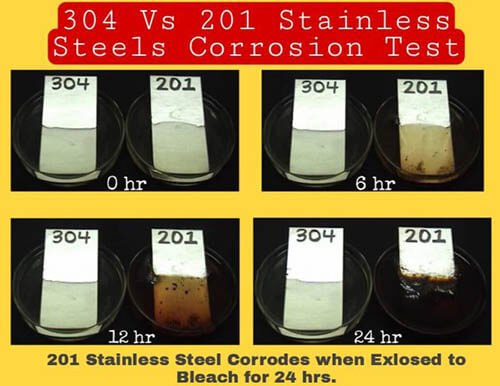
Pic source:elkayusa
These kinds are compared in detail in the below chart, including their safe uses:
|
|
201 Stainless Steel |
304 Stainless Steel |
316 Stainless Steel |
|
Chromium |
16% - 18% |
18% |
16% |
|
Nickel |
3.5% - 5.5% |
8% |
10% |
|
Rust Resistance |
Least |
Medium |
Can even be used to contain salty ocean water |
|
Brittle |
More |
Less |
Less |
|
Cookware safe |
Mostly |
Yes |
Yes |
|
Drinkware safe |
No |
Yes |
Yes |
|
Price |
Lowest |
Medium |
Highest |
7. Nylon Vs Silicone Cooking Utensils
Nylon and silicone are both popular materials especially for cooking utensils. Many people want to know which one is better. The main differences between nylon and silicone cooking equipment are given below:
|
Nylon |
Silicone |
|
|
Heat Resistance |
400° F ( 204.4° C ) |
482° F ( 250° C ) |
|
Crack Resistance |
Crack easily and harbor microorganism |
Do not Crack easily but can also harbor microorganisms when cracked |
|
Non-stick |
Yes |
Yes |
|
Leach Harmful Chemicals |
DDM etc. |
None |
|
Dishwasher Safe |
Yes |
Yes |
|
LifeSpan |
Less than Silicone |
More than Nylon |
|
Price |
Less |
More |
Final Words
After reading this comprehensive guide about kitchen utensil materials, you must benefit a lot. Share it with your friends or on Facebook, Twitter, Quora, Reddit. Or leave a message below to let me help you if you have any problems.
We’re Jingsourcing, a leading sourcing company in China. If you’re interested in wholesaling or customizing kitchen utensils of different materials, please feel free to CONTACT US.

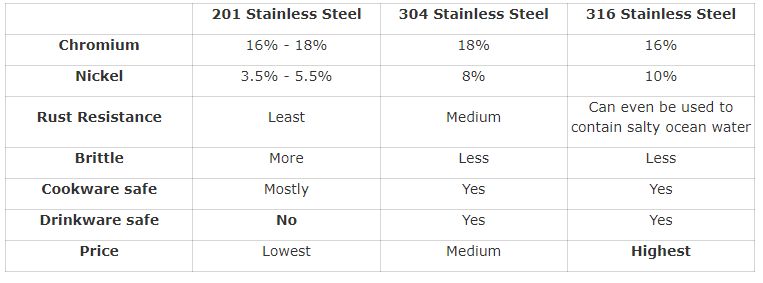
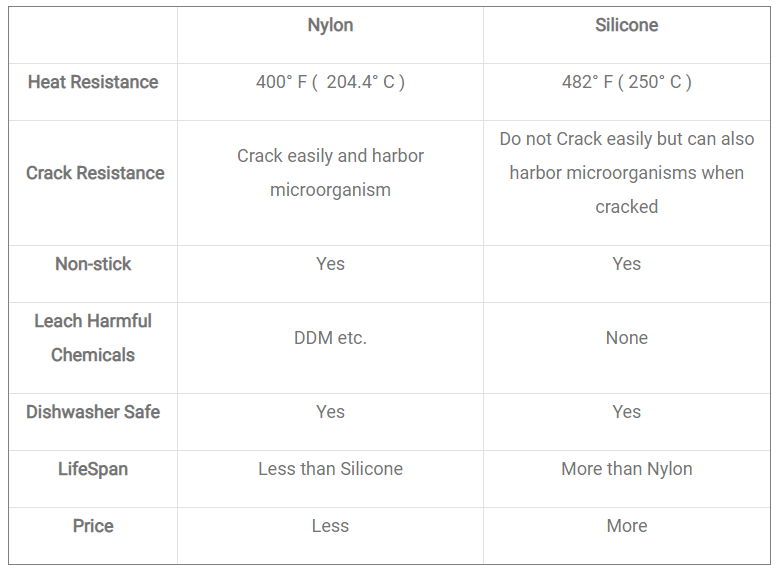

Leave A Comment